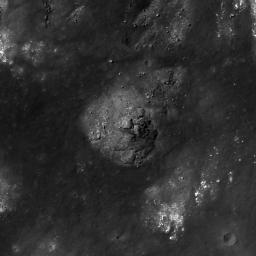
|
Gassendi A
- Click the image above for a larger view
- Full-Res JPEG (900 x 900) (85.1 kB)
- Full-Res TIFF (900 x 900) (811.0 kB)
Caption:
Impact melt material inside of the crater Gassendi A, which intrudes into the northern rim of the larger crater Gassendi. LROC NAC image M107136013L, image width is 840 meters (2756 feet).
The crater Gassendi is 110 kilometers (68 miles) in diameter and located on the northern edge of Mare Humorum at 17.5°S, 39.9°W. Gassendi features an array of intersecting fractures on its floor, collectively known as the Rimae Gassendi. Some of the largest fractures are thousands of meters wide. The origin of these fractures in the floor of Gassendi is not known for certain. After the impact the floor of Gassendi was molten and as it cooled, a crust of solid material formed at the surface. As the entire crater floor continued to cool and settle into its final shape, fractures could have formed due to the forces caused by these changes.
Background Info:
NASA's Goddard Space Flight Center built and manages the mission for the Exploration Systems Mission Directorate at NASA Headquarters in Washington. The Lunar Reconnaissance Orbiter Camera was designed to acquire data for landing site certification and to conduct polar illumination studies and global mapping. Operated by Arizona State University, LROC consists of a pair of narrow-angle cameras (NAC) and a single wide-angle camera (WAC). The mission is expected to return over 70 terabytes of image data.
Cataloging Keywords:
| Name | Value | Additional Values |
|---|---|---|
| Target | Moon | |
| System | Earth | |
| Target Type | Satellite | |
| Mission | Lunar Reconnaissance Orbiter (LRO) | |
| Instrument Host | Lunar Reconnaissance Orbiter | |
| Host Type | Orbiter | |
| Instrument | Lunar Reconnaissance Orbiter Camera (NAC) | |
| Detector | Narrow Angle Camera (NAC), Wide Angle Camera (WAC) | |
| Extra Keywords | Crater, Grayscale, Impact | |
| Acquisition Date | ||
| Release Date | 2010-11-05 | |
| Date in Caption | ||
| Image Credit | NASA/GSFC/Arizona State University | |
| Source | photojournal.jpl.nasa.gov/catalog/PIA13679 | |
| Identifier | PIA13679 | |
